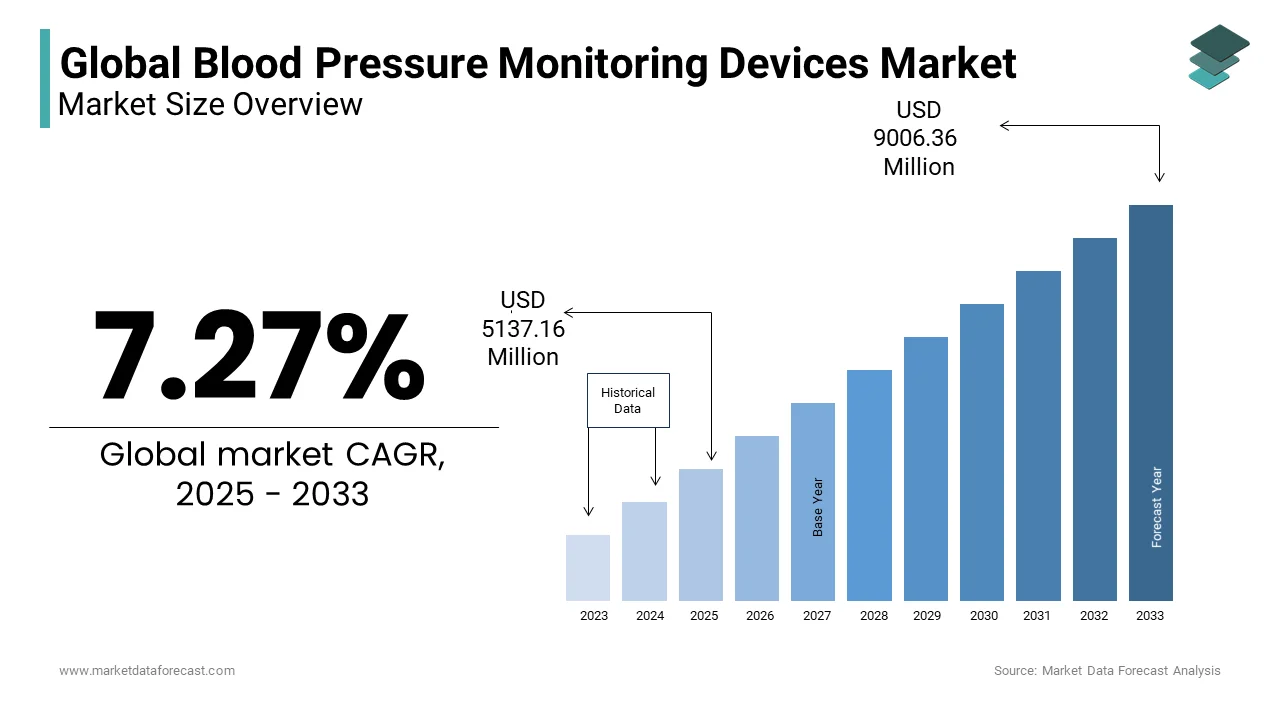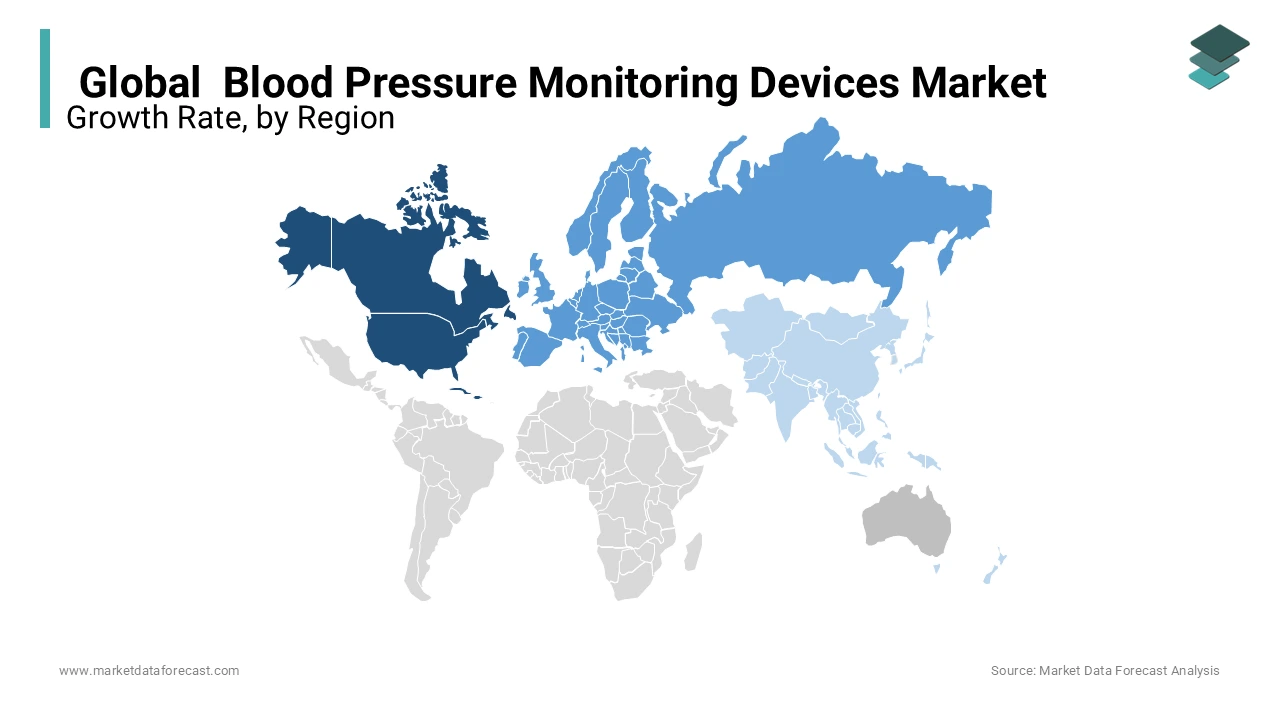Global Blood Pressure Monitoring Devices Market Size, Share, Trends & Growth Forecast Report – Segmented By Type (Automated B.P. Monitors, Ambulatory B.P. Monitors, Sphygmomanometers, B.P. Transducers and B.P. instruments accessories) and Region (North America, Europe, Asia Pacific, Latin America, and Middle East & Africa) - Industry Analysis (2025 to 2033)
Global Blood Pressure Monitoring Devices Market Size
In 2024, the global blood pressure monitoring devices market was valued at USD 4789 million and it is expected to reach USD 9006.36 million by 2033 from USD 5137.16 million in 2025, growing at a CAGR of 7.27% during the forecast period.

Blood pressure monitoring devices are used to measure blood pressure within the arteries. Blood pressure monitoring devices play an essential role in the measurement, management and monitoring of hypertension. Blood pressure monitoring devices are highly accurate and help physicians or doctors ensure effective treatment. These devices are highly accurate and assist physicians or medical professionals in providing efficient treatment for patients. A person must have an accurate blood pressure reading to avoid heart diseases and strokes. The blood pressure in younger people is said to have read 140/90 mm Hg, and people aged 65 years and older are likely to have 150/80 mm Hg. Blood pressure is caused due to hypertension, especially in men. Therefore, people will likely have their blood pressure tests done at home using their devices instead of visiting diagnostic labs or clinics. The common blood pressure symptoms are severe headaches, vision problems, irregular or fast heartbeat, and more.
MARKET DRIVERS
The rising incidence of cardiovascular and chronic diseases worldwide is a key driving factor for the blood pressure monitoring devices market.
The demand for B.P. monitors is growing steadily because of the growing geriatric population and the increasing risk of lifestyle-associated complications due to rising incidences of obesity & sedentary lifestyles. Furthermore, demographic trends, such as increasing longevity, will drive the market over the forecast period. But on the other hand, hypertension causes premature deaths. Therefore, it should be treated well at a specific time when blood pressure monitoring devices play a crucial role in continuously monitoring patients' blood pressure and notifying any abnormalities. So, increasing incidences of hypertension are expanding the market's growth tremendously.
The technological advancements in hypertension monitoring promote the growth of the blood pressure monitoring devices market. The technologically advanced products are much more convenient and comfortable than conventional equipment. In addition, increasing government initiatives to prevent the mortality attributed to hypertension and the growing requirement for portable equipment will drive the BP monitoring devices market over the forecast period.
The growing investments from the governmental and non-governmental in the healthcare sector is supporting the growth of the blood pressure monitoring devices market.
The rapidly increasing elderly population globally is also elevating the growth of the blood pressure monitoring devices market. Growth opportunities for the market lie in the emergence of technological advancements in the medical sector and innovative products that are highly accurate and convenient for the end-users. Also, the introduction of portable devices that can be easily used anywhere is prompting the market's growth. Furthermore, in modern days, the Internet of Things plays a significant role in promoting the patient's well-being, which is also ascribed to bolster the growth rate of the blood pressure monitoring devices market. In addition, increasing knowledge of wireless transmission devices in hospitals and ambulatory services is escalating the global market growth.
MARKET RESTRAINTS
The shortage of skilled technicians in resolving system failure in real-time applications is hindering the blood glucose monitoring devices market.
Lack of standardization is one more factor degrading the development of the market. The cost of some devices manufactured with advanced features is a little high, which remains challenging for the market developers. In addition, stringent rules and regulations by the government in approving new devices restrict the growth of the blood pressure monitoring devices market. Excessive costs for technological developments, lack of trained physicians coupled with low awareness in underdeveloped countries, and to some extent in developing nations, may hinder the market growth of blood pressure monitoring devices.
REPORT COVERAGE
|
REPORT METRIC |
DETAILS |
|
Market Size Available |
2024 to 2033 |
|
Base Year |
2024 |
|
Forecast Period |
2025 to 2033 |
|
Segments Covered |
By Type and Region |
|
Various Analyses Covered |
Global, Regional & Country Level Analysis, Segment-Level Analysis, Drivers, Challenges, Restraints, Opportunities; PESTLE Analysis; Porter's Five Forces Analysis, Competitive Landscape, Analyst Overview of Investment Opportunities |
|
Regions Covered |
North America, Europe, Asia Pacific, Latin America, Middle East & Africa |
|
Key Market Players |
G.E. Healthcare, Welch Allyn, A&D Medical Inc., SunTech Medical, Rossmax International Ltd, Spacelabs Healthcare Inc., Panasonic Corporation, Philips Healthcare, Contec Medical Systems Co. Ltd, Omron Healthcare, and Microlife AG. |
SEGMENTAL ANALYSIS
By Type
In terms of revenue share, the sphygmomanometer segment dominated the product type with a 45% share in 2024 and is expected to show lucrative growth over the forecast period. Technological advancements and new product launches are expected to fuel the demand for sphygmomanometers worldwide. Demand for digital sphygmomanometers is expected to grow at a lucrative CAGR due to benefits such as accurate results and ease of use. Besides, continuous technological improvements, such as advances in wearable technology, apps, and mobiles in the consumer healthcare segment, the declining average selling price for retailers and manufacturers, and rising penetration in the professional market are the factors propelling the market growth.

REGIONAL ANALYSIS
North America dominated the global blood pressure monitoring devices market in 2024, followed by Europe. Factors such as the increasing prevalence of chronic and acute diseases such as hypertension and cardiac diseases, technological advancements, the acceptability of non-invasive pressure monitors among patients, and the existence of key market players in North America drive the market growth in the North American region. In addition, increasing investments in developing accurate and efficient BP monitors are expected to contribute to the growth of blood pressure monitoring devices in the coming years.
Moreover, new product launches and technological progress are expected to drive the market further. Moreover, a growing preference for home healthcare and information about the significance of the early diagnosis of hypertension & cardiac diseases is also expected to boost the region's market growth.
Denmark and the U.K. have governed the European market due to the successful launch of telehealth services. Public Health England determined that around 13.4 million people in England have undiagnosed or B.P. recorded hypertension. The population of England is rapidly aging, and the average life expectancy is high. In addition, favorable government initiatives such as 'The Blood Pressure Action Plan' will impact the rendering factor. The promising demographic trends and high prevalence should boost the U.K. hypertension monitoring devices market.

On the other hand, Asia-Pacific is expected to grow rapidly over the forecast period. Increasing investment by the government, growing awareness levels, rising incidences of hypertension, and the number of undiagnosed high B.P. are key factors contributing to this regional market growth. Furthermore, the Asia-Pacific market is expected to expand rapidly over the forecast due to untapped possibilities, increasing expenditures by manufacturers, growing awareness levels, and rising hypertension incidences. In addition, rapidly developing healthcare amenities and the skyrocketing number of undiagnosed & untreated cases of high B.P. are key determinants contributing to this regional market growth.
Supportive government drives for increasing awareness among people and a rapidly growing target disease population base are adding to the profitable growth of the B.P. monitoring devices market in this region. Furthermore, in May 2018, The Indian Council of Medical Research started the "May Measurement Month 2018" campaign to increase alertness about blood pressure, which is the principal cause of fatality and morbidity in India. As a result, the Indian blood pressure monitoring devices market will observe notable growth due to the expanding patient pool. In addition, the high pervasiveness of obesity and diabetes will further drive regional growth.
KEY MARKET PLAYERS
Companies leading the global blood pressure monitoring devices market profiled in the report are G.E. Healthcare, Welch Allyn, A&D Medical Inc., SunTech Medical, Rossmax International Ltd, Spacelabs Healthcare Inc., Panasonic Corporation, Philips Healthcare, Contec Medical Systems Co. Ltd, Omron Healthcare, and Microlife AG.
RECENT HAPPENINGS IN THE MARKET
- In January 2017, Omron EVOLV was introduced by Omron Healthcare Inc., which has been a great success due to its superior features. This device is a portable upper arm blood pressure monitor and wireless device.
- The collaboration of PhysIQ Inc. and Omron Healthcare in February 2019 brought many changes in the product portfolio and merged many devices for effective outcomes. For example, the integration of the heart guide wearable B.P. monitor of Omron into the pinpointIQ platform can be used effectively in outpatient facilities.
MARKET SEGMENTATION
This research report on the global blood pressure monitoring devices market has been segmented and sub-segmented based on type and region.
By Type
- Automated B.P. Monitors
- Ambulatory B.P. Monitors
- Sphygmomanometers
- Mercury
- Aneroid
- Digital
- B.P. Transducers
- B.P. instruments accessories
By Region
- North America
- Europe
- Asia Pacific
- Latin America
- Middle East and Africa
Frequently Asked Questions
Which region led the blood pressure monitoring devices market in 2024?
Geographically, the North American region dominated the market in 2024.
Which segment by type dominated the blood pressure monitoring devices market in 2024?
Based on type, the sphygmomanometer segment led the market in 2024.
What was the size of the global blood pressure monitoring devices market in 2024?
The global blood pressure monitoring devices market size was worth USD 5137.16 million in 2024
Related Reports
Access the study in MULTIPLE FORMATS
Purchase options starting from $ 2500
Didn’t find what you’re looking for?
TALK TO OUR ANALYST TEAM
Need something within your budget?
NO WORRIES! WE GOT YOU COVERED!
Call us on: +1 888 702 9696 (U.S Toll Free)
Write to us: [email protected]
